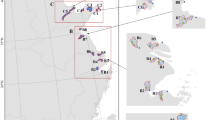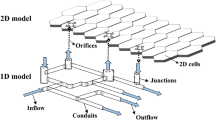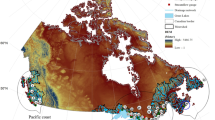Abstract
The performance of urban drainage system (UDS) and green infrastructures (GI) significantly depends on the accurate determination of the rainfall characteristics of an urban area, especially because these rainfall characteristic variables are closely related. A bivariate copula method is used to evaluate and compare the joint impact of rainfall depth and duration on the hydrological performance of UDS and GI by considering the dependent structure of flood drivers. The peak flow, peak flow occurrence time, outflow, runoff coefficient, overflow, and resilience serve as the performance indicators. The estimated joint probability based on the optimal copula is used to define the boundary conditions for the calibrated Storm Water Management Model to simulate the hydrological process and the magnitude of floods caused by various combination of rainfall depth and durations. Results demonstrate that considering the dependence structure of rainfall characteristics, especially for the peak flow, runoff coefficient, and overflow, is critical for the comprehensive evaluation of the performance of the UDS. Neglecting the interaction between flood drivers can lead to overestimating the performance of UDS and GI in mitigating urban flood risk. The GI can effectively reduce urban flood and improve resilience, which varies with rainfall characteristics. Our results suggest that the utilization of accurate data on rainfall characteristics enhances the performance of the GI in flood mitigation and resilience improvement.




Similar content being viewed by others
Data Availability
Data are available from the corresponding author.
References
Akaike H (1998) Information Theory and an Extension of the Maximum Likelihood Principle. In E. Parzen, K. Tanabe, & G. Kitagawa (Eds.), Selected Papers of Hirotugu Akaike (pp. 199–213). New York, NY: Springer New York
Balistrocchi M, Bacchi B (2017) Derivation of flood frequency curves through a bivariate rainfall distribution based on copula functions: application to an urban catchment in northern Italy’s climate. Hydrol Res 48(3):749–762. https://doi.org/10.2166/nh.2017.109
Chowdhary H, Escobar LA, Singh VP (2011) Identification of suitable copulas for bivariate frequency analysis of flood peak and flood volume data. Hydrol Res 42(2–3):193–216. https://doi.org/10.2166/nh.2011.065
Dong X, Guo H, Zeng S (2017) Enhancing future resilience in urban drainage system: Green versus grey infrastructure. Water Res 124:280–289. https://doi.org/10.1016/j.watres.2017.07.038
Fiori A, Volpi E (2020) On the effectiveness of LID infrastructures for the attenuation of urban flooding at the catchment scale. Water Resour Res 56(5)
Fletcher TD, Shuster W, Hunt WF et al (2015) SUDS, LID, BMPs, WSUD and more – The evolution and application of terminology surrounding urban drainage. Urban Water J 12(7):525–542. https://doi.org/10.1080/1573062X.2014.916314
Frahm G, Junker M, Schmidt R (2005) Estimating the tail-dependence coefficient: Properties and pitfalls. Insur Math Econ 37(1):80–100. https://doi.org/10.1016/j.insmatheco.2005.05.008
Fu G, Butler D (2014) Copula-based frequency analysis of overflow and flooding in urban drainage systems. J Hydrol 510:49–58. https://doi.org/10.1016/j.jhydrol.2013.12.006
Guo X, Guo Q, Zhou Z et al (2019) Degrees of hydrologic restoration by low impact development practices under different runoff volume capture goals. Journal of Hydrology, 578, 124069. https://doi.org/10.1016/j.jhydrol.2019.124069
Hu M, Zhang X, Li Y et al (2019) Flood mitigation performance of low impact development technologies under different storms for retrofitting an urbanized area. J Clean Prod 222:373–380. https://doi.org/10.1016/j.jclepro.2019.03.044
Hua P, Yang W, Qi X et al (2020) Evaluating the effect of urban flooding reduction strategies in response to design rainfall and low impact development. J Clean Prod 242:118515. https://doi.org/10.1016/j.jclepro.2019.118515
Huff FA (1967) Time distribution of rainfall in heavy storms. Water Resour Res 3(4):1007–1019. https://doi.org/10.1029/WR003i004p01007
IPCC (2022) Climate Change 2022: Impacts, adaptation and vulnerability. Contribution of working Group II to the sixth assessment report of the intergovernmental panel on climate change. https://www.ipcc.ch/report/sixth-assessment-report-working-group-ii/
Jun C, Qin X, Gan TY et al (2017) Bivariate frequency analysis of rainfall intensity and duration for urban stormwater infrastructure design. J Hydrol 553:374–383. https://doi.org/10.1016/j.jhydrol.2017.08.004
Li H, Gao HK, Zhou YL et al (2022) Urban flood modeling of a partially separated and combined drainage system in the Grefsen Basin in Oslo, Norway. J Water Manag Model 30:C480. https://doi.org/10.14796/JWMM.C480
Liang CY, You GJY, Lee HY (2019) Investigating the effectiveness and optimal spatial arrangement of low-impact development facilities. J Hydrol 577:124008. https://doi.org/10.1016/j.jhydrol.2019.124008
Mao X, Jia H, Yu SL (2017) Assessing the ecological benefits of aggregate LID-BMPs through modelling. Ecol Modell 353:139–149. https://doi.org/10.1016/j.ecolmodel.2016.10.018
Peng Z, Jinyan K, Wenbin P et al (2019) Effects of Low-Impact Development on Urban Rainfall Runoff under Different Rainfall Characteristics. Pol J Environ Stud 28(2):771–783. https://doi.org/10.15244/pjoes/85348
Poulin A, Huard D, Favre AC et al (2007) Importance of Tail Dependence in Bivariate Frequency Analysis. J Hydrol Eng 12(4):394–403. https://doi.org/10.1061/(ASCE)1084-0699(2007)12:4(394)
Qin HP, Li ZX, Fu G (2013) The effects of low impact development on urban flooding under different rainfall characteristics. J Environ Manage 129:577–585. https://doi.org/10.1016/j.jenvman.2013.08.026
Rossman LA (2010) Storm Water Management Model User’s Manual, Version 5.0. National Risk Management Research Laboratory, Office of Research and Development, US Environmental Protection Agency.
Salvadori G, De Michele C (2010) Multivariate multiparameter extreme value models and return periods: A copula approach. Water Resour Res 46(10). https://doi.org/10.1029/2009WR009040
Schwarz G (1978) Estimating dimension of a model. Ann Stat 6(2):461–464. https://doi.org/10.1214/aos/1176344136
Shafique M, Kim R (2018) Recent progress in low-impact development in south korea: water-management policies, challenges and opportunities. Water 10(4). Retrieved from https://doi.org/10.3390/w10040435
Sklar A (1959) Fonctions de répartition à n dimensions et leurs marges. Publications de l’Institut Statistique de Université de Paris 8
Vandenberghe S, Verhoest NEC, Onof C et al (2011) A comparative copula-based bivariate frequency analysis of observed and simulated storm events: A case study on Bartlett-Lewis modeled rainfall. Water Resour Res 47(7). https://doi.org/10.1029/2009WR008388
Wang D, Fu X, Luan Q et al (2020) Effectiveness assessment of urban waterlogging mitigation for low impact development in semi-mountainous regions under different storm conditions. Hydrol Res 52(1):284–304. https://doi.org/10.2166/nh.2020.052
Wang X, Xia J, Zhou M et al (2022) Assessment of the joint impact of rainfall and river water level on urban flooding in Wuhan City. China. J Hydrol 613:128419. https://doi.org/10.1016/j.jhydrol.2022.128419
Xie K, Kim JS, Hu L et al (2023) Intelligent Scheduling of Urban Drainage Systems: Effective Local Adaptation Strategies for Increased Climate Variability. Water Resour Manage 73:91–111. https://doi.org/10.1007/s11269-022-03357-0
Yang Y, Li J, Huang Q et al (2021) Performance assessment of sponge city infrastructure on stormwater outflows using isochrone and SWMM models. J Hydrol 597:126151. https://doi.org/10.1016/j.jhydrol.2021.126151
Zellou B, Rahali H (2019) Assessment of the joint impact of extreme rainfall and storm surge on the risk of flooding in a coastal area. J Hydrol 569:647–665. https://doi.org/10.1016/j.jhydrol.2018.12.028
Zhu Z, Chen X (2017) Evaluating the effects of low impact development practices on urban flooding under different rainfall intensities. Water 9(7). https://doi.org/10.3390/w9070548
Acknowledgements
This is supported by the National Natural Science Fund of China (52009092) and also a collaborative research achievement of the Smart Water Institute (SWI), Wuhan University and Seoul Institute of Technology (SIT) supported by the Seoul Institute of Technology (2021-AB-008), Seoul, South Korea.
Author information
Authors and Affiliations
Corresponding author
Ethics declarations
Ethical Approval
The authors declare that they have no conflict of interest.
Consent to Participate
The authors declare that they are aware and consent with their participation on this paper.
Consent to Publish
The authors declare that they are consent with the publication of this paper.
Competing Interests
There is not any competing interest.
Additional information
Publisher's Note
Springer Nature remains neutral with regard to jurisdictional claims in published maps and institutional affiliations.
Appendix
Appendix
1.1 C1. Gumbel, Clayton, and Frank Copula
where u and v are uniformly distributed random variables, which is the cumulative distribution function of rainfall depth (X) and duration (Y); C \(\in\) [0, 1]2 is copula function.
1.2 C2. The Definition of RMSE, BIC, and AIC
where k is the number of parameters of the copula model; N represents the number of samples; \(C({u}_{i},{v}_{i})\) represents the theoretical frequency; \({C}_{n}({u}_{i},{v}_{i})\) represents the empirical frequency.
1.3 C3. Performance Indicators
Single factor and synthetical index are adopted to study the impact of marginal distribution and correlation of rainfall depth and duration on the performance of drainage system, and to assess the flood control performance of urban drainage systems with or without LID strategies under joint rainfall events considering both rainfall depth and duration. Single factor indicators include peak flow, time of peak flow, total outflow, runoff coefficient, and overflow. Resilience index (Eq. (13)) indicates the synthetical index used for measuring the resilience of the drainage system is employed. Considering the layout of local drainage system, two system functionalities are included in the definition of resilience, including social benefit and technological benefit. The social benefit represents the capacity to prevent urban flooding, and the technological benefit indicates the capacity of the pump to process extra water during rainfall events.
The definition of resilience is shown below:
where \({k}_{s}\) and \({k}_{t}\) are the weights of urban flooding and pump capacity, \({k}_{s}={k}_{t}=1\); \({Sev}_{s}\) is the overflow amount of manhole in drainage system indicating the urban flooding; \({Sev}_{t}\) is the residual water volume of front pool exceeding the treatment capacity of pump station water; \({Q}_{R}\) is surface runoff generated by rainfall event; \({t}_{fi}\) represents the overflow time at ith time step; \(t\) represents the total time of simulation; \({t}_{ti}\) is the duration when Qpi exceeds capacity of ith pump; Qpi represents the inflow of ith pump from its front-pool. \({Ca}_{pumpi}\) represents the capacity of ith pump.
1.4 C4. Detailed Information of GI Design
The application of Green infrastructure (GI) is promoted for runoff control, flood mitigation, and resilience improvement, including green roof, porous pavement, and so on (Mao et al. 2017). Seoul city focused on applying green infrastructure in existing areas to make the city sustainable (Shafique and Kim 2018). In this study, green infrastructures, including Green Roof (GR) and Porous Pavement (PP) are arranged and simulated to assess its performance on improving city safety and resilience. The physical parameter of green infrastructure for each type is defined according to the previous papers in South Korea and US EPA design guidelines. For GR, the applied area is based on the public building and residential/commercial area. For PP, the arranged area is based on the pavement and parking plot. It should be noted that the area proportion of green infrastructure in this study indicates the proportion of the specific site area mentioned above. For both GR and PP, different proportions are designed, including 10%, 20%, 30%, and 50%. Finally, GR and PP with identical proportions are combined to display the combined control.
1.5 C5. Detailed Information of Marginal Distributions and Dependence Structure
The parameters with 95% confidence intervals of copulas are concluded in Appendix Table 2. The parameter values based on the relationship between parameter and rank relative factor are 1.585, 1.170, 3.751 for Gumbel, Clayton, and Frank copulas, respectively, which coincide with the parametric estimates and bracketed in 95% confidence interval excepting Clayton copula.
Rights and permissions
Springer Nature or its licensor (e.g. a society or other partner) holds exclusive rights to this article under a publishing agreement with the author(s) or other rightsholder(s); author self-archiving of the accepted manuscript version of this article is solely governed by the terms of such publishing agreement and applicable law.
About this article
Cite this article
Xie, K., He, Y., Kim, JS. et al. Assessment of the Joint Impact of Rainfall Characteristics on Urban Flooding and Resilience Using the Copula Method. Water Resour Manage 37, 1765–1784 (2023). https://doi.org/10.1007/s11269-023-03453-9
Received:
Accepted:
Published:
Issue Date:
DOI: https://doi.org/10.1007/s11269-023-03453-9






